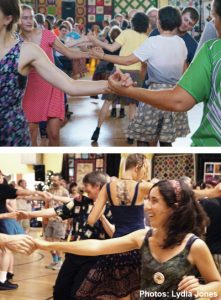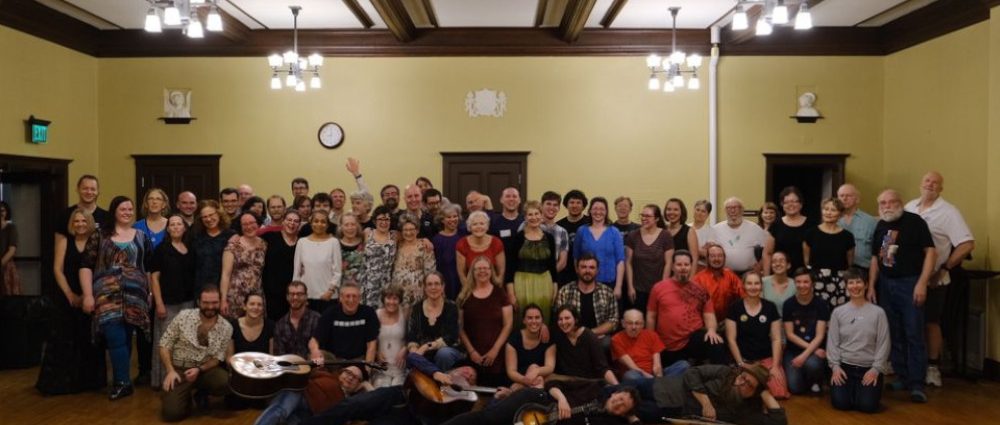 I walked into the Gates of Heaven Synagogue in Madison, Wisconsin and soaked up the quaint setting. The elegant and sturdy stone building fit the scene too well and made me feel like I was perhaps stepping into a community dance in 1863. Nope, just a tight knit community keeping the traditional music and dances of early America alive and well.
I walked into the Gates of Heaven Synagogue in Madison, Wisconsin and soaked up the quaint setting. The elegant and sturdy stone building fit the scene too well and made me feel like I was perhaps stepping into a community dance in 1863. Nope, just a tight knit community keeping the traditional music and dances of early America alive and well.
Contra dancing is a uniquely American past-time and has managed to migrate from small community dances around the country into a national network of enthusiasts. It blends the music and dance of immigrants from around the world.The dancing ends up looking like a blend of square and English country dancing, while the music blends the sounds and tunes of old time, European folk, Appalachian, Irish and French Canadian traditions. From rural barns, churches and community rooms to school gyms and grand dance halls, you can now find a contra dance subculture in every region of the country, and the Driftless is no exception. Wisconsin boasts lively contra groups in Viroqua, Gay’s Mills and Madison among others, but as a Madisonian that’s the one I checked out first. I arrived early to seek out my target: Bill Obermeyer. He was too easy to spot, one of a duo warming up for the night by filling the empty synagogue with lively folk tunes. He played guitar, accompanying a woman on fiddle. They each had the look and sound of masters of their craft, which they easily are- they’ve each been at this for over twenty years and they dip and sway with the songs that come easily through their well practiced hands. When I approached Bill, he introduced me to his fiddling companion, Carol Ormand, who was happily another subject matter expert and long-time contra dancer.
I arrived early to seek out my target: Bill Obermeyer. He was too easy to spot, one of a duo warming up for the night by filling the empty synagogue with lively folk tunes. He played guitar, accompanying a woman on fiddle. They each had the look and sound of masters of their craft, which they easily are- they’ve each been at this for over twenty years and they dip and sway with the songs that come easily through their well practiced hands. When I approached Bill, he introduced me to his fiddling companion, Carol Ormand, who was happily another subject matter expert and long-time contra dancer.
As we started chatting, I asked them what they liked so much about contra dancing in this region. They both settled on a major theme that was clear to see on the dance floor that night: community. “We all know when something happens in someone’s life and we all come together to support them,” Carol explained. “It’s that aspect of community that we rarely find in many areas of our life.” As a group that meets at least weekly, there is a continuity of friendships- for many of the dancers spanning decades- that leads to a lot of laughing, hugs and conversation on the floor. Despite the strong vein of veteran dancers who take the floor every week, newcomers and beginners (especially students from the University of Wisconsin, Madison) are not at all uncommon and keep the dances fresh. You don’t have to have any experience to be welcomed in automatically, encouraged, helped and warmly lead through the dances.
Many people are surprised by how easy contra dancing is to pick up as a beginner. If you arrive early, you can often get a short lesson for new folks to get acquainted with the steps, and each new dance gets a practice run-through before the music starts. Another fun fact and breath of fresh air to the intimidated newbie: someone (the “caller”) calls out the steps on a loudspeaker for at least the first half of the dance. The figures are simple and beginners often pair with experienced dancers who can lead them through the steps as the caller says them. Carol has been calling (and even composing) dances since 1997, and has been a fixture at dance events around the country- even as far as England and Denmark. If you’re lucky enough to have someone as experienced and personable as her leading the dance, your first go at it will be great. As she assured me, “If you can remember to alternate your two left feet you’ll be fine!”
One thing that sets contra dancing apart from many other styles of dance, including its close cousin square dancing, is the fact that there is always a live band. The weekly dance in Madison features a unique band affectionately known as the “MOB”, Madison Open Band. Here, not only are new dancers welcome to the floor any time, but musicians are welcome to join the band as well. They keep open access to their repertoire and sets, and have enough repetition week-to-week that new members can have plenty of practice. For Carol Ormand, a classically trained violinist, it provides a weekly outlet to continue playing.
I asked Carol what else being involved in the contra dancing community here has brought her. She grinned and answered by bird-calling across the hall “Hey, sweetiesweetiesweetiesweetie!” A tall dancer popped his head around the corner and echoed the call back to her with a grin. “That one,” she said, “we met at a dance and we’re married 14 years now.” Bill Obermeyer has a similar story. He smiled as he recounted, “Just about the first person I met in Madison was at a contra dance, and she’s my wife now.” He then rattled off another seven or eight names of couples who had met and married through this dancing community.
You can find regular dances throughout the region, but if you find yourself near the Gates of Heaven Synagogue some Tuesday night, stop on by and see what it’s all about. It’s great exercise, fabulous music, and in the summer there are often pre-dance potlucks. Plus, if you’re in the market for a spouse… you just never know.
By Lydia Jones![]()
2021-03-21

